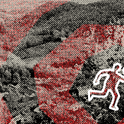The view from Notre Dame de la Garde, where people bring gifts to the Virgin to thank her for saving their lives(photo: Superstock)
When I told French friends I was going to Marseille to research a book, they were horrified. They said the only things the Marseillais have ever been famous for are football (at which they cheat), soap (which they never use) and the national anthem (which is actually Alsatian). These days, I was told, almost all of them are either on benefits or heroin, or some sort of jihad.
“Be careful,” said one Parisian. “Marseille is like a bomb.”
So, from the French perspective, it’s an odd choice as the European Capital of Culture for 2013. There’s never been much encouragement to go there. For years, the cheap airlines stayed away (and Eurostar still stops just short of the city). In guidebooks, it was a place to be endured, not enjoyed. Until recently, only one hotel had more than three stars and there were no proper museums, boutiques, Disneylands or intelligible works of art. This was strange, considering that Marseille is Europe’s third biggest port, and the oldest and most spacious city in France.
And now? Arriving in Marseille is like falling through several layers of history and ending up just short of the present. From a distance, the knobbly, desiccated mountains of the Côte d’Azur look much as they did to the Phocaeans, who founded “Massalia” in 600BC. Closer in, it looks more Roman: foothills covered in pantiles and villas. Millennia pass, and you’re soon in among the great 16th-century forts. The villas meanwhile have turned into tenements, and the harbour is now a vast rectangular basin.
This basin, Le Vieux Port, is still the focal point of the city. It’s like a room full of sea or an enormous box of light, packed with thousands of yachts. During my stay, I spent hours on this great limestone rim. It’s a cacophony of fish and sirens, whistles, drunks, Ferraris, sunlight and raï. Each day would begin with a fish market—as it has for the past 26 centuries—and then people would drift down, out of the hills, just to gather on the edge of their magnificent, liquid piazza.
Way above is a basilica, Notre Dame de la Garde. It’s slim and candy-striped, and, on the top, is a vast golden Virgin, carrying a baby the size of a small plump elephant. If the Virgin were ever to lose her battle with gravity, she’d crash her way through several neighbourhoods before blocking off the port. People bring her gifts for saving their life, and, amongst this catastrophe kitsch, there are dented helmets, lifebuoys, false limbs, and, for some reason, Didier Drogba’s number 11 football shirt.
From the port, the main street looks like the gateway to France; an enormous portal of columns and voluptuous nymphs. La Canebière, wrote Conrad, is “a street leading into the unknown.” Two blocks up, however, the glory falters. The stockbrokers have gone and the nymphs look as if they’d just clambered out of the coal. Meanwhile, the Hôtel Louvre et Paix has become a rather Soviet department store. According to a plaque, Mark Twain once stayed here, amongst the socks and pants.
The Marseillais don’t seem to mind the fall from grace, and seek their escape in food. Even in the roughest corner of the city you can find something exquisite to eat. Forget bouillabaisse (an expensive local wheeze, foisted on tourists). No, Marseille’s gift is simplicity, that by-product of sunlight and poverty. It was Elizabeth David who brought it back to Britain. It was called “Mediterranean cuisine” but most of it she found here, in the soot. Perhaps my favourite eatery is the crumbling Pizzaria Etienne, over in Le Panier.
When I first climbed up to Le Panier (“The Basket”), I had a sudden feeling that—like the proverbial cat—curiosity would eventually get the better of me, and here was a prowl too far. Once home to Napoleon and Casanova, this quarter has worked hard to earn its name: it’s a dense lattice of lanes, criss-crossed with rat-runs leading deeper into the dark. It was, however, never as satanic as I’d imagined. Everything had a pastel glow and the shops sold soap and scented paper. Although it was still defiantly foxy in parts, tales of depravity had, it seemed, lingered long into gentrification.
Another place the city will flaunt next year is Le Corbusier’s Cité Radieuse. Built between 1946 and 1952, it rises from the clutter like a concrete tooth. Its streets in the sky were supposed to have been “a machine for living.” Architects may worship it, but I don’t. It reminds me of too many places that it’s inspired; the sink estates of the 1960s, slums from here to Bombay, and the gigantic dentistry of Soviet Europe. The locals, I discovered, called it La Maison du Fada, or The House of the Raving Mad.
For all its faults, by the end of my stay, Marseille had become one of my favourite cities. It horrified me how much I felt at ease amongst its cheery, foul-mouthed, fish-faced citizens, and it was impossible not to enjoy their world, however brash and cheap. I loved the hand-painted cars, the streets of lime trees, the voluptuous plasterwork, the elaborate displays of dogs, and the flea-markets with all their war-clubs and clogs. I loved, too, the way that, during the day, the city worked itself into a frenzy of heat and litter, and then each morning opened the fire-hydrants and washed it all away. So there it is: my unhealthy affection for Marseille.












